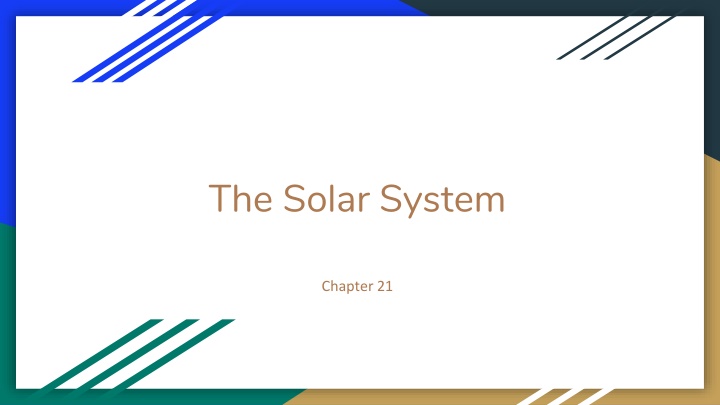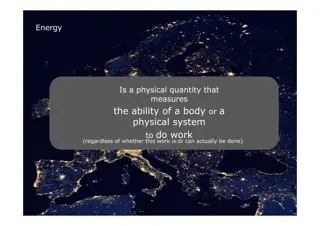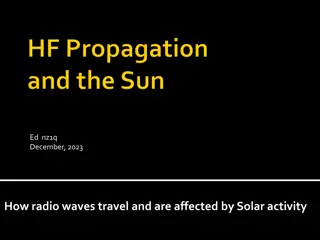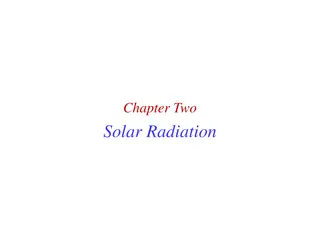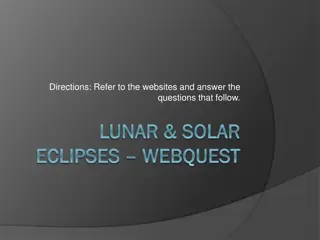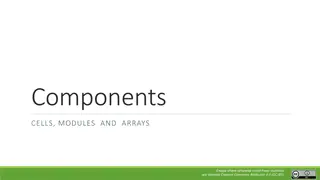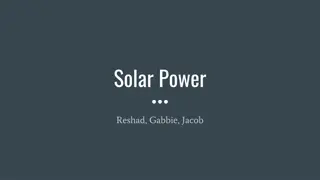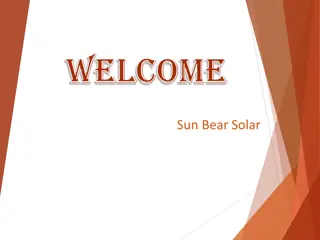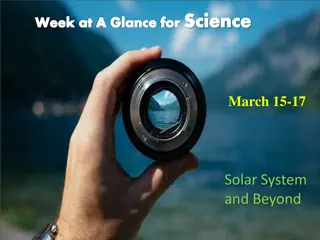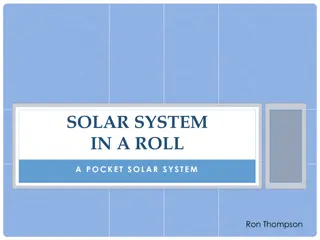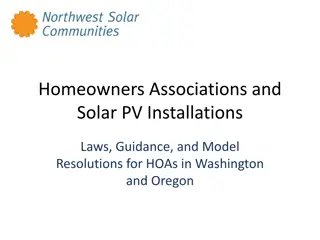Exploring the Solar System: A Fascinating Journey
Delve into the structure of the solar system, with the sun at its center surrounded by planets, asteroids, and comets. Learn about the inner rocky planets, outer gas giants, and tiny dwarf planets. Discover how distance is measured in space using astronomical units and unravel the motion of planets as they orbit the sun.
Download Presentation

Please find below an Image/Link to download the presentation.
The content on the website is provided AS IS for your information and personal use only. It may not be sold, licensed, or shared on other websites without obtaining consent from the author.If you encounter any issues during the download, it is possible that the publisher has removed the file from their server.
You are allowed to download the files provided on this website for personal or commercial use, subject to the condition that they are used lawfully. All files are the property of their respective owners.
The content on the website is provided AS IS for your information and personal use only. It may not be sold, licensed, or shared on other websites without obtaining consent from the author.
E N D
Presentation Transcript
The Solar System Chapter 21
21.1 Structure of the Solar System The sun is the center of our solar system The sun and 9 planets make up our solar system Planets wander or orbit around the sun at different distances Sometimes when we view stars, we actually see planets that appear to be stars Venus is the closest planet to Earth and is easily seen most nights Stars are much farther away than planets so appear as tiny specks of light
Objects in the Solar System Sun: largest star in the solar system-makes up 99%, 10x larger than Jupiter, made of gases (hydrogen) The sun produces energy through nuclear fusion and applies gravity to all planets Planets: reflect sunlight, spherical shaped object that orbits sun, classified/grouped as inner, outer, dwarf Asteroids: small rocky objects orbiting sun between Mars & Jupiter (belt), range in size Comets: Gas, dust, and ice orbiting sun and producing a glowing tail (melting), trillions in space
Planets Inner: terrestrial/rocky: Mercury, Venus, Earth, Mars; smaller than outer planets Outer: gas giants: Jupiter, Saturn, Uranus, Neptune; larger than inner planets Dwarf: tiny mass, made of rock and ice: Pluto, Ceres, Eris, Makemake
Measuring Space AU-astronomical unit is used to measure distance in space It is the average distance from Earth to the sun About 150 million kilometers Each planet s AU increases as it gets farther from the sun See Chart p. 764
Motion of Planets Sun s gravitational pull on each planet prevents planets from drifting apart and keeps each planet on a curved path around the sun Revolution/revolve-is the time it takes a planet to travel once around the sun (year) Rotation/spinning on axis-is the time it takes planet to spin once on the axis (day) Copernicus proposed the idea that Earth and other planets orbit the sun (heliocentric model) instead of Earth being in the center (geocentric model) in 1500 s Kepler discovered in 1600 s that planet s orbit is an ellipse and not a perfect circle and speed increases near the sun
21.2 Inner Planets Terrestrial planets are closest to the sun and made of rock/metal; have solid outer layers Different sizes, atmospheres, and surfaces See p. 769
Mercury Smallest and closest to the sun No atmosphere/wind, extreme changes in temps, many craters due to no erosion, solidified lava, cliffs Very little change over time Core, mantle, and crust Largest impact crater in solar system: Caloris Basin 1550 km across formed billions of years ago P. 770 See Red Table
Venus Second closest to sun, hottest, about same size as Earth, many probes and landers visited Dense atmosphere of CO2 & thick acidic clouds cover the planet Greenhouse effect traps energy 80% is covered with solidified lava A day is longer than a year due to slow rotation; rotates east to west Core, mantle, and crust p. 771 See Red Table
Earth third rock from the sun Third planet from the sun; has a moon Protective atmosphere provides water and temps to support life Greenhouse effect traps energy Only planet with liquid water on the surface Core, mantle, crust Crust is broken into pieces/ plates that constantly move to create and destroy more crust P. 772 See Red Table
Mars Fourth from the sun; reddish color due to iron oxide (rust) in the soil; many probes have visited No water or life; polar ice caps hint to water once being available Thin atmosphere of CO2, extreme temps, Covered with craters and solidified lava; large & long lasting dust storms Valles Marineris- largecanyon; larger that the U.S. Martian Olympus volacano- largest mountain in solar system; wide as Arizona and higher than Everest P. 773 See Red Table
21.3 Outer Planets Gas giants with liquid interiors-hydrogen and helium Small solid cores Strong gravitational pull due to large mass/size All have a rings
Jupiter 5th planet, largest-twice the mass of all other planets combined, thick atmosphere of clouds Rotates faster than any other planet causing dense, colorful clouds to stretch out and appear as rings Solid core surrounded by liquid hydrogen- mostly made of hydrogen & helium 63+ moons (more than any other planet), discovered by Galileo so the 4 largest are Galilean moons Io, Europa, Ganymede, and Callisto are all made of rock and ice P. 778 See Red Tables
Saturn 6th planet, considered the ringed planet due to 7 bands of rings of chunky ice and stretched clouds Least dense planet Solid core with layer of liquid hydrogen and gas outer layer - mostly made of hydrogen and helium 60+ moons; largest is Titan and it is the only moon in the solar system with an atmosphere P. 779 See Red Table
Uranus 7th planet, seems to orbit the sun like a rolling ball due to sideways tilt So far away, only 1 space probe (Voyager 2) explored it in 1986 Thick atmosphere with thick, slushy layer of water and ammonia - mostly made of hydrogen & helium and methane gas We assume it has a core surrounded by water, ice and gases 27+ moons P. 780 See Red Table
Neptune 8th planet with not as much knowledge due to lack of exploration Voyager 2 explored it in 1989 (took 3 years to travel from Uranus to Neptune) Huge storm (dark spot) was detected in 1989 but gone 5 years later Atmosphere made of hydrogen, helium and methane gas 13+ moons P. 781 See Red Table
21.4 Other Space Objects Dwarf planets are objects that orbit the sun, has enough mass & gravity to form a sphere and has other similar objects orbiting near it-new classification in 2006 Pluto, Ceres (smallest), Eris, (largest) MakeMake, and Haumea are dwarf planets All are smaller than our moon Pluto is size of our moon, very cold (frozen), 3 moons, and takes 248 years to revolve around the sun Explored by the Hubble Telescope
Asteroids & Comets Most asteroids are located in the asteroid belt & orbit the sun; made of chunks of rock and ice tightly clumped together Some asteroids are larger than your school Comets also orbit the sun but produce a coma (bright tail) of melting ice; tail burns on opposite side of sun Comets are loosely clumps of ice and gas See p. 787
Meteoroids Small rocky object that moves through space; produces a streak of light in Earth s atmosphere called meteor; once it collides with another object/planet it is a meteorite Most are the size of a grain of sand The collision of meteorites forms an impact crater-round depression formed on the planet More than 170 impact craters on Earth (Wetumpka, AL)
TEST TIME Know vocab Study main ideas on p, 792 Complete review p. 793-795 Read about the confusing topics in the textbook Google confusing topics Study highlighted bullets on Power Point
